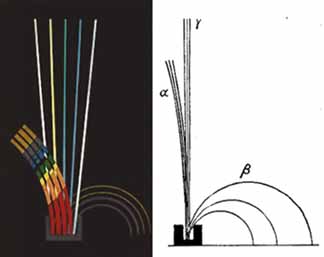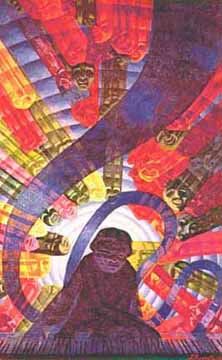| Art & Technology | |
| - Synaesthesia |
Picabia's work "music is like painting" comes across as a seriously funny take on the European tradition of colour music. Not only is the title an ironic reversal, giving painting precedence over music, but Picabia unashamedly plagiarized a common scientific chart (above, right), showing the effects of a magnetic field on alpha, beta and gamma particles. The result seems to lampoon the pretensions of Enlightenment colour-music codes, and mock their intellectual credibility.

Picabia's
work "music is like painting" comes across as a seriously funny take
on the European tradition of colour music. Not only is the title an ironic reversal,
giving painting precedence over music, but Picabia unashamedly plagiarized a
common scientific chart (above, right), showing the effects of a magnetic field
on alpha, beta and gamma particles. The result seems to lampoon the pretensions
of Enlightenment colour-music codes, and mock their intellectual credibility.
Only when we know the artist counted Busoni, an arranger of Bach's music, among
his composer friends, do we begin to realize that - funnily enough - he might
be serious. Of the many statements the Dadaist painter made connecting colour
with music, none is more cryptic than: "We tend towards the White considered
as a psychic entity or, in order to concretize this tendency thanks to immutable
rapports of colour and music, we tend towards 'la' pure = 435 vibrations." We
are seemingly being told, in the best occult tradition of colour music, that
white and the note A have a physical correspondence and represent, in different
forms, the same mystical goal.
It is
the tempered scale, further rationalized, that we have inherited today. Modern
keyboards, both acoustic and electric, employ a basic method of tuning called
equal temperament, whereby the octave is evenly divided into twelve semitones
by a logarithmic progression. The octave (an interval between two notes of the
same name, created by doubling the frequency of the lower note) is the only
remaining aspect of Western music that might be said to accord with natural
laws. The bottom A on the piano has its frequency doubled seven times over,
producing a cycle of seven octaves, from A to A, before the end of the keyboard
is reached. This man-made construct gives us a mathematical and homogeneous
system for organising sound into music across the audible range.
Music has evolved over millennia, through many compromises,
to a relatively 'impure' state, and its contrived formulae are not echoed in
the natural phenomena of the spectrum. Neither can any unifying principle be
meaningfully divined from the separate vibrations of light and sound: disparities
between them are clear and fundamental. To connect pitch and colour by a relationship
of frequencies would require a formula so convoluted as to be ridiculous - not
that this has stopped many from trying. Helmholtz noted one mid-19th century
example, that raised Pythagorean ratios to the power of six-sevenths in order
to match notes with colours, but rightly pointed out that such a process made
arithmetic nonsense of the original musical proportions.
Helmholtz
realized Newton's alignment of the spectrum to a musical system was physically
preposterous. Still, in the spirit of the times, he toyed with its aesthetic
possibilities; he claimed unnamed Italian painters had preferred his favourite
primaries of red, green and blue and hoped to find musical support for this
thesis. But he had to admit the spectrum of light contains no equivalent of
the basic musical octave, let alone the intervals within it. A comparable light
octave might be envisaged by doubling the lowest red frequency, but doing so
takes one immediately beyond the range of visible light. The spectrum, from
red to violet, can barely span three-quarters of one such 'colour octave', let
alone encompass the cycles of octaves used in music.
Newton's optics went some way to provide a consensual model
of the spectrum, but his colour-music analogy of ROYGBIV was no more than a
pretty conceit. But the search for an overarching unity of colour and music
continued, and even today parallels are being drawn with pure and spectral light.
There are those that still marvel to discover that frequencies of certain notes,
when doubled forty times over, can fall within the measurable range of visible
light. In some quarters, the size of the spectrum has been exaggerated beyond
the range of average vision (personal testimony included as proof), to create
a colour octave. Naive or cynical, such conjuring tricks with dimensions have
taken hold in New Age movements, being used to justify nefarious correspondences
under the venerable name of Helmholtz's pupil, Hertz.
The musical
possibilities of ROYGBIV were explored as early as 1734, with limited success,
by Louis-Bertrand Castel. His ocular harpsichord displayed coloured strips of
paper whenever notes were struck. Castel had at first hailed Newton as his inspiration
(with passing reference to the previous colour music theories of Athanasius
Kircher), and his original colours formed a spectral array. But by 1740, Castel
was using natural colouring materials arranged in a twelve-hued colour circle,
and aligned to a twelve-note chromatic scale cycling over many octaves. Encouraged
by the composer Rameau, Castel embraced a triadic theory of harmony that gave
the primary colours blue, yellow and red the note values C, E and G, making
up the common chord of C major, the white-note scale. The spectral order of
the primaries was reversed to place blue at the bottom, where its expressive
capabilities could best represent the musical ground-base, so important to the
theories of Rameau.
It was not until the end of the 18th century, when subjective
colour effects were attracting scientific attention, that interest in practical
connections between colour and music re-emerged. After repeating Newton's experiments
with colour discs, Count Rumford ruminated on the possibility of:
 Illustration 10 : "MUSIC." Luigi Russolo, 1911.
Illustration 10 : "MUSIC." Luigi Russolo, 1911.
Though he joined
the Futurists as a militant painter, Russolo soon turned his attention to music.
He created a range of novel instruments, called intonarumori, and published
"The Art of Noises" in 1916. His concerts were attended by the musical and artistic
elite of Europe, as well as the press and rowdy Dada protesters. Russolo's concert
career was curtailed by talking pictures in the 1930s, and he turned to studying
folk music and Eastern mysticism (unlike many other Futurists, he avoided joining
the Fascisti). By trying to break down the distinction between musical sound
and everyday noise, in exploiting the secondary vibrations of his instruments,
Russolo prefigured the concrete music of the 1950s. His legacy remains in computer
music, where his notation system is still used.
Russolo's painting might suggest a belief in correspondences of colour to music.
The clearest clue is provided in a manifesto on "The Painting of Sounds, Noises
and Smells", by his comrade Carlo Carrą: - "...rrrrrrreds that shouuuuuuut,
greeeeeeeeeeeens that screeeeeeam, yellows, as violent as can be." Other Futurists,
the brothers Ginna and Corra, committed themselves to a spectral colour-music
code inspired by their Theosophical beliefs. Bruno Corra's "Abstract Cinema-Chromatic
Music" provides an intriguing account of the techniques the brothers used, employing
the code first on a colour piano then translating the effects to film in 1910-12.
Richard Wagner put out the call for a Gesamtkunstwerk in 1850, a new kind of theatre that would synthesize music, verse and staging into a unified, total artwork. His Beyreuth playhouse introduced the wedge-shaped amphitheatre, hidden orchestra and darkened auditorium, to which audiences are now accustomed. With the introduction of arc lighting (and incandescent globes soon after), theatrical illusion was near complete. Loie Fuller, the Parisian dancer, put these effects to good use, timing her movements in response to atmospheric lighting. Wafting diaphanous veils under ever-changing coloured lights, she inspired Toulouse-Lautrec and D. W. Griffith and influenced Isadora Duncan and Martha Graham. Other were also effected by the Wagnerian spirit. Kandinsky wrote stage pieces from 1909 to exemplify the new values: "The Yellow Sound", "Black and White" and "Violet" , employed the colours themselves, in motion to music, as the central characters. Unfortunately, his works proved too difficult to mount. Around the same time, Schoenberg composed "The Lucky Hand", to be accompanied by a range of colours according to no known theory:
The technical
ingenuity of the late 19th century gave rise to a number of colour music instruments,
like Rimington's or Bainbridge Bishop's (the latter being displayed by P. T.
Barnum). Typically, they took the form of a standard organ console with a screen
above it, onto which different colours were projected - usually a standard spectrum
was divided into a progression to match the C scale. Colour musicians often
justified their work with references to science, spirituality and the grand
order of nature, while the press shared their enthusiasm for a potentially revolutionary
new art form. The musical component of colour music was frequently eclipsed
by the novelty of colour music instruments. Thomas Wilfred, sponsored by prominent
Theosophists, had devised large spectacles in New York in 1916; he later invented
the Clavilux, his light organ, to perform Lumia concerts. By 1930, he had put
the Home Clavilux on the market. Before the advent of television, a buyer could
install a cabinet in the corner of the living room that silently generated visual
imagery for days - without producing the same pattern twice.
After World War I, some film-makers had turned their attention
to colour music as an ideal subject for abstract animations. Sometimes, they
might collaborate with an artist (Viking Eggerling with Hans Richter) or work
with a colour organist (Oskar Fischinger with Alexander Laszlo). Their valuable
innovations were often obscured by later advances in mainstream film - the advent
of talkies and colour films - and public attention diverted to bowdlerized versions
of colour music, such as Disney's "Fantasia".
Not until the rock shows of the 1960s and 70s did colour music
regain a large audience, with psychedelic performances synthesizing light and
sound. Pioneering work in electronics and computing enabled animators to participate
in major films as well - John Whitney's contribution to the Stargate Corridor
sequence in "2001: A Space Odyssey" being one example. The effort to co-ordinate
colour and music on domestic computers has led to further software advances.
In exploring possible interrelationship of colour and music, programmers have
been obliged to analyse anew the formal elements, to map flexible links between
any arrangements of pitch, colour, shape, movement and so on. Video makers and
live performers have been able to take advantage of the broad theories supplied
by traditional colour music. Even something of its persistent mysticism has
been readily assimilated in the age of multimedia. Modern computing and animation
experts can (and often do) claim a lineage that extends back through colour
organists and animators of the early 20th century, to Castel's Ocular Harpsichord
in the 18th century - even unto Athanasius Kircher's magic lanterns and Arca
Musarithmica (mechanically-composed music) of 1600.